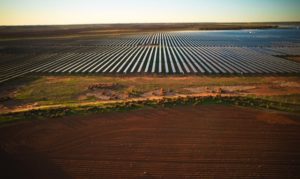The cost of solar power across the globe continues to fall, with the first auction for solar PV projects in Brazil attracting bids which are among the lowest in the world.
Brazil held its first “solar only” energy auction last Friday, looking to set contract prices for at last 500MW of solar capacity.
The bidding was fierce. More than 400 projects with a total capacity of over 10,000MW were bid into the auction. The result was that the ceiling of 262 reais per megawatt hour was easily beaten, and the average offer for more than 1,080MW of accepted bids was 215.12 reais, or $US87/MWh.That it among the lowest solar prices anywhere in the world and, importantly, it is without subsidy.
 Brazil has already found that wind and solar are both cheaper than building new coal or gas fired generation.
Brazil has already found that wind and solar are both cheaper than building new coal or gas fired generation.
In India, a tender last week for 500MW of solar capacity in the sunny, south-eastern state of Andhra Pradesh, resulted in First Solar submitting the cheapest bids with on offer of $86/MWh and $US87/MWh for two 40MW solar plants. That result was significant, because it is below the price required to make coal imports economically viable.
In the US, they are making similar discoveries. Last month, the utility in Georgia, reeling from cost over-runs at its nuclear plant, attracted an average price of $65/MWh for 500MW of solar capacity (that includes a 30 per cent tax credit).
In previous months, Austin Energy in Texas recently signed a PPA for 150MW of solar for $US50/MWh; in Colorado, Xcel Energy said it can buy electricity from 170MW of solar plants for less than buying from natural gas plants; and in Utah, Rocky Mountain Power also chose to go solar as their default energy source.
Australian solar developers believe costs of solar plant in Australia can also fall, but only with policy certainty that encourage development so that the cost of finance, in particular, can fall.
Tim Buckley, the director of Energy Finance Studies, Australasia, at the Institute of Energy Economics and Financial Analysis, says the evidence from US, India and Brazil is conclusive – solar is rapidly becoming price competitive, able to be installed rapidly and on a very large scale basis.
“If only the regulators and politicians would get out of the way, it would be happening here in Australia as well,” Buckley said.
“The international Energy Agency last month forecast 5% price declines for solar technology annually going forward through to 2050. Ongoing electricity deflation and sector transformation is an inevitable and unstoppable outcome of this trend.
“How much more evidence do we need to see before Australian energy sector incumbents are willing to move? Using regulatory barriers to delay this inevitability will only increase the amount of stranded assets that result.”
Brazil currently gets less than one percent of its electricity from solar – in fact it has only 14.6MW of solar power connected to grid and another 30MW off-grid. More than 70 per cent from hydroelectric plants, but wants to use more solar to diversify its electricity supply in the face of the worst drought in eight decades.
Yayoi Sekine, a Sao Paulo-based analyst at Bloomberg New Energy Finance, said the results of the auction suggested Brazil was trending toward the cheapest solar contract prices without subsidies in the world.
At this level, projects are unlikely to return more than 10 per cent on investment, she said.
“It was the most competitive energy auction Brazil ever had,” Mauricio Tolmasquim, president of the Energy Research Agency, told Bloomberg. “The sale was a milestone for the entrance of solar energy in the Brazilian energy mix.”
Brazil has set a goal of having 3.5 gigawatts of solar capacity in operation by 2023, producing about 1.8 per cent of the country’s energy.
A separate auction for wind energy projects results in 769MW agreed at an average price of 142.34 reais/MWh. Wind energy has surpassed wholesale parity in Brazil and is by the far the cheapest in the country’s capacity auctions – so much so that a separate category had to be created for fossil fuels.










